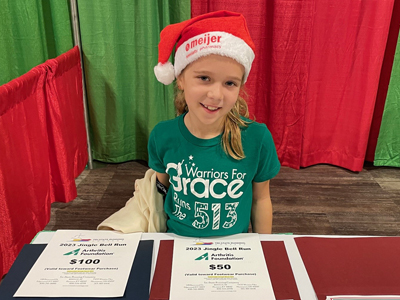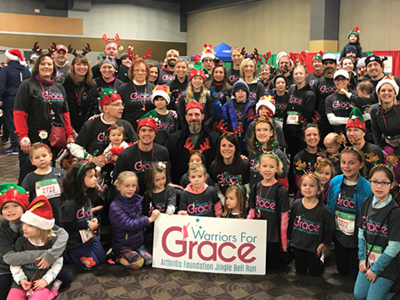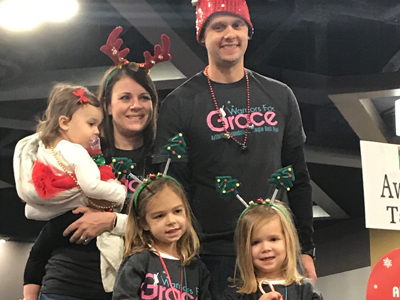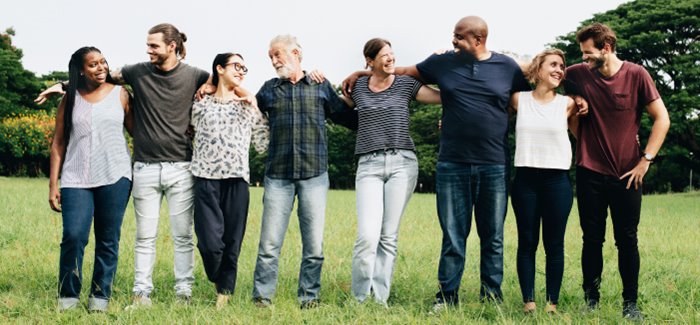Learning to Live and Give With Juvenile Arthritis
Making connections and making a difference has been a lifeline for this JA family.
By Allison Wilcosky | May 8, 2024
 Jessica was a mom of two young children, with another child on the way when her youngest, Grace, kept waking up early every morning — cranky.
Jessica was a mom of two young children, with another child on the way when her youngest, Grace, kept waking up early every morning — cranky.
“She was probably 19 or 20 months old. I thought, OK, we’re just hitting a sleep regression,” says Jessica, “but sometimes she was inconsolable.”
One morning, Jessica went to lie with her on the couch when Grace’s foot was accidentally pinned down.
“She screamed bloody murder, and I thought I had broken her foot or something,” says Jessica. “I had no idea what was going on.”
Grace calmed down after some ibuprofen, but when she got back up, she started dragging her foot behind her. After a doctor’s visit and X-ray, they couldn’t find anything wrong and advised Jessica to go to an orthopedist if Grace was still limping a week later.
“Fast forward, probably four or five orthopedist visits later because she’s still limping, and they couldn’t find anything wrong,” explains Jessica. “There was a nurse practitioner we saw, and I told her, ‘You’ve got to do something,’ but she just kept saying ‘Give it time.’ But give what time? After that, Grace ended up getting an MRI.”
The MRI revealed swelling in Grace’s ankle and knee joints. Subsequent lab work revealed what the doctors described to Jessica as a classic case of arthritis.
“I didn’t even know kids could get arthritis,” Jessica shares. “They gave her some steroid injections and found it in her eyes as well.”
Grace is 9 years old now and has had regular shots to treat her juvenile arthritis (JA) for the past seven years. “We tried to go off at one point and that didn’t work very well. But you wouldn’t know she had arthritis looking at her,” says Jessica. “She does everything she wants to do; runs, jumps, plays, dances, plays basketball, swims. We’ve been pretty lucky, so knock on all the things because I’ve read about what that looks like when and if her medication doesn’t work anymore.”
Jingling All the Way
 A year after Grace’s diagnosis, the family was connected to their local Arthritis Foundation office in Cincinnati and Grace was nominated as the honoree for the Jingle Bell Run.
A year after Grace’s diagnosis, the family was connected to their local Arthritis Foundation office in Cincinnati and Grace was nominated as the honoree for the Jingle Bell Run.
“Once we saw what the Foundation was doing, we had no choice but to be all in,” says Jessica. “My husband and I are, for better or worse, extreme go-getters. We said if we were going to do the Jingle Bell Run, we were going to raise a lot of money.”
And raise the money they have. Over the last six years, the family has raised over $100,000 for their team, Warriors for Grace.
“We’re lucky to live in a community that is small but insanely supportive. We throw a big bowling party every year in November to raise money for Warriors for Grace,” says Jessica. “We also have a lot of generous family and friends who care, love and support Grace.”
The day of the event is often hectic for the family between other commitments, but they enjoy going and being part of the festivities.
Making Connections
 In addition to Jingle Bell Run, Jessica also serves on the local board, organizing local JA events.
In addition to Jingle Bell Run, Jessica also serves on the local board, organizing local JA events.
“COVID kind of wrecked everybody and took everything out that was put in place. We’re in the process of rebuilding all that, but we do quarterly JA events for families because we know how important it is to get them together, so they know that they’re not alone,” Jessica explains. “Building a network is going to be huge in the long run. This is not something that’s going away or going to change for us.”
Grace is also starting to come into her own for these events.
“She recognizes kids here and there,” says Jessica. “She likes the idea of being able to help other kids. When we had our JA Day last year, she was like a mother hen to the kindergarten, preschool-aged kids.”
But for Jessica, the connection to the Arthritis Foundation is a lifeline.
“I stay home with the kids, so this gives me a great purpose and a passion beyond that,” Jessica says. She shares one connection she’s built recently. “I've also made a great connection with the family of a boy that was diagnosed last October and the mom came to our JA Day. She just couldn't stop crying. He had only been diagnosed for three or four months. She and I have built this sweet, little friendship. I'll send her a text every once in a while, and she’ll ask me questions.”
Jessica admits, having JA in the family can be isolating, so making these connections are vital for JA families. Just being around people who get it doesn’t happen enough, she says.
“For the first few years, I really didn't have anyone who understood and who knew and was going through the same things,” Jessica reflects. “I can talk to my friends or my family about it until I'm blue in the face, but they still don't get it. This has been life-giving in the way of community and support, and also knowing you’re helping someone else out, too.”
 Jessica was a mom of two young children, with another child on the way when her youngest, Grace, kept waking up early every morning — cranky.
Jessica was a mom of two young children, with another child on the way when her youngest, Grace, kept waking up early every morning — cranky.“She was probably 19 or 20 months old. I thought, OK, we’re just hitting a sleep regression,” says Jessica, “but sometimes she was inconsolable.”
One morning, Jessica went to lie with her on the couch when Grace’s foot was accidentally pinned down.
“She screamed bloody murder, and I thought I had broken her foot or something,” says Jessica. “I had no idea what was going on.”
Grace calmed down after some ibuprofen, but when she got back up, she started dragging her foot behind her. After a doctor’s visit and X-ray, they couldn’t find anything wrong and advised Jessica to go to an orthopedist if Grace was still limping a week later.
“Fast forward, probably four or five orthopedist visits later because she’s still limping, and they couldn’t find anything wrong,” explains Jessica. “There was a nurse practitioner we saw, and I told her, ‘You’ve got to do something,’ but she just kept saying ‘Give it time.’ But give what time? After that, Grace ended up getting an MRI.”
The MRI revealed swelling in Grace’s ankle and knee joints. Subsequent lab work revealed what the doctors described to Jessica as a classic case of arthritis.
“I didn’t even know kids could get arthritis,” Jessica shares. “They gave her some steroid injections and found it in her eyes as well.”
Grace is 9 years old now and has had regular shots to treat her juvenile arthritis (JA) for the past seven years. “We tried to go off at one point and that didn’t work very well. But you wouldn’t know she had arthritis looking at her,” says Jessica. “She does everything she wants to do; runs, jumps, plays, dances, plays basketball, swims. We’ve been pretty lucky, so knock on all the things because I’ve read about what that looks like when and if her medication doesn’t work anymore.”
Jingling All the Way
 A year after Grace’s diagnosis, the family was connected to their local Arthritis Foundation office in Cincinnati and Grace was nominated as the honoree for the Jingle Bell Run.
A year after Grace’s diagnosis, the family was connected to their local Arthritis Foundation office in Cincinnati and Grace was nominated as the honoree for the Jingle Bell Run.“Once we saw what the Foundation was doing, we had no choice but to be all in,” says Jessica. “My husband and I are, for better or worse, extreme go-getters. We said if we were going to do the Jingle Bell Run, we were going to raise a lot of money.”
And raise the money they have. Over the last six years, the family has raised over $100,000 for their team, Warriors for Grace.
“We’re lucky to live in a community that is small but insanely supportive. We throw a big bowling party every year in November to raise money for Warriors for Grace,” says Jessica. “We also have a lot of generous family and friends who care, love and support Grace.”
The day of the event is often hectic for the family between other commitments, but they enjoy going and being part of the festivities.
Making Connections
 In addition to Jingle Bell Run, Jessica also serves on the local board, organizing local JA events.
In addition to Jingle Bell Run, Jessica also serves on the local board, organizing local JA events.“COVID kind of wrecked everybody and took everything out that was put in place. We’re in the process of rebuilding all that, but we do quarterly JA events for families because we know how important it is to get them together, so they know that they’re not alone,” Jessica explains. “Building a network is going to be huge in the long run. This is not something that’s going away or going to change for us.”
Grace is also starting to come into her own for these events.
“She recognizes kids here and there,” says Jessica. “She likes the idea of being able to help other kids. When we had our JA Day last year, she was like a mother hen to the kindergarten, preschool-aged kids.”
But for Jessica, the connection to the Arthritis Foundation is a lifeline.
“I stay home with the kids, so this gives me a great purpose and a passion beyond that,” Jessica says. She shares one connection she’s built recently. “I've also made a great connection with the family of a boy that was diagnosed last October and the mom came to our JA Day. She just couldn't stop crying. He had only been diagnosed for three or four months. She and I have built this sweet, little friendship. I'll send her a text every once in a while, and she’ll ask me questions.”
Jessica admits, having JA in the family can be isolating, so making these connections are vital for JA families. Just being around people who get it doesn’t happen enough, she says.
“For the first few years, I really didn't have anyone who understood and who knew and was going through the same things,” Jessica reflects. “I can talk to my friends or my family about it until I'm blue in the face, but they still don't get it. This has been life-giving in the way of community and support, and also knowing you’re helping someone else out, too.”
Story of Yes
Say Yes! Share Your Story
One of the most powerful things you can do to help others living with arthritis is share your story. If you have arthritis, care for someone who does or are making an impact in the arthritis community, your experiences can help someone who may feel alone. Whether you're a patient, caregiver, donor, volunteer or researcher — you can be an inspiration by sharing your Story of Yes.
Share Your Story
Read Previous
Jennifer Ziegler: Empowered to Help Others Living With Arthritis
Read Next
Ways to Volunteer
Stay in the Know. Live in the Yes.
Get involved with the arthritis community. Tell us a little about yourself and, based on your interests, you’ll receive emails packed with the latest information and resources to live your best life and connect with others.
